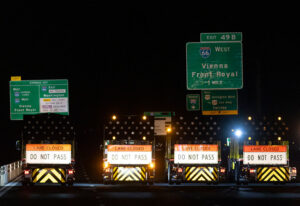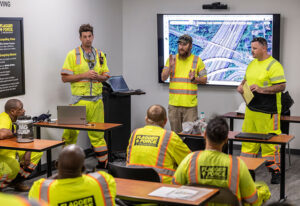5 Miles. 38 Trucks. 46 Teammates. One Mission.
This summer, Flagger Force crews took on one of the biggest and boldest projects in company history: a 5-mile rolling slowdown across two of Virginia’s busiest highways, requiring the specialized expertise that only our team brings to the industry.
The mission? Help a utility contractor replace high-voltage power lines: a job that called for months of planning, split-second timing, and some serious teamwork.
“On jobs like this, success depends on everyone working together and supporting one another.”—Matt Ginn, Area Supervisor, Flagger Force
So, What’s a Rolling Slowdown?
Think of it like a perfectly choreographed traffic operation. Our convoy of trucks moves in formation at a reduced and safe speed, slowing vehicles just long enough to create a “traffic-free window” of about 10 to 20 minutes at a time, so utility crews overhead can work safely on critical infrastructure projects.
These rolling windows are precise, but they’re vital. Each one creates just enough time for utility contractors to maneuver safely in the air while thousands of drivers wait on the ground. When done right, the operation looks smooth and seamless, but it requires extraordinary coordination between crews on the ground, utility workers overhead, and law enforcement keeping both sides of the highway in sync.
It’s complex. It’s high stakes. And when it works, it looks effortless.
Big Project, Big Numbers
Executing a rolling slowdown of this size requires significant resources and coordination. The numbers tell part of the story, but the scale behind them paints the full picture:
- 90 pieces of equipment: including 34 Truck-Mounted Attenuators (TMAs) and 34 specialized signs, multiple Flagger Force pickup trucks, 22 Variable Message Sign (VMS) boards, and support vehicles, each strategically positioned to protect crews and manage traffic flow.
- 46 team members: a mix of experienced and highly trained operators and new drivers who benefited from mentorship and education throughout the project.
- Multiple law enforcement partners: working alongside our crews to reinforce safety and ensure motorists understood the slowdown was both controlled and temporary.
- Weeks of preparation: with VMS boards placed in advance to inform drivers, plus more than 40 hours of route mapping, staging, and operational planning.
- 2 days to execute: the team had only 2 days of rolling slowdowns scheduled, so precision was needed
Because the project spanned two highways and nearby rail lines, our teams also had to maintain flexibility and focus and be ready to adjust operations at a moment’s notice.
Night Owls at Work
The work was carried out overnight, beginning around 11:00 p.m. and sometimes extending until 4:00 a.m. These hours minimized disruption for daytime travelers while giving crews the safe windows they needed to perform the work. The highways looked very different: headlights stretched into the distance, radios cracked with instructions, and trucks moved in precise formation. Each Flagger Force team member had a defined role, and every movement mattered.
The first rolling slowdown was successfully executed in June, but the work didn’t stop there. Crews conducted an after-action review, identifying lessons learned and making improvements. The second rolling slowdown occurred in July and the operation was even sharper, proving the value of continuous improvement.

Preparation Backed by the Operations Service Center
The success of this project started long before the first truck rolled onto the highway. It took months of preparation and the steady support of our Operations Service Center (OSC), which served as the backbone of the operation.
The OSC coordinated every moving piece, from scheduling crews, securing equipment, and keeping communication lines open with law enforcement and client partners. During live operations, they acted as the central hub, monitoring progress in real time and troubleshooting challenges so that field leaders and crews could stay focused on execution.
Preparation included:
- Two months of planning and more than 40 hours of coordination meetings.
- Staging equipment as close to the location of work in a way that would not impede normal day-to-day commutes.
- Placement of variable message boards weeks in advance to inform the traveling public.
- A final prep call the week prior to align every detail.
- Comprehensive pre-job briefings to ensure every Flagger Force team member understood their role.
“All of this was part of a comprehensive effort from our Operations Logistics team, which includes Resource Allocation and Fleet & Warehouse, ensuring our field crews could focus on working safely, developing the job, and delivering quality results.”—Ross Miller, Senior Operations Logistics Manager, Flagger Force
This strong foundation of planning, combined with the OSC’s constant support, gave our crews confidence to perform under pressure. Leadership from Area Supervisors Matt Ginn and Joseph Bringley, Field Manager Brett Lonie, and Safety Professional Marlin Rainey tied it all together, guiding the team through one of the most complex projects in Flagger Force history.

The Result
The project wrapped up with high praise for detail, execution, and safety. For our team, it was more than just another job; it was the largest project we’ve ever completed and a shining example of what being Safety-Driven® looks like in action.
More Than Traffic Control
At its core, this project was about more than moving vehicles or managing lanes. It was about teamwork, mentorship, adaptability, and a commitment to learning from every experience. It showed why our clients trust Flagger Force with their most complex and high-stakes projects, and why our crews continue to set the standard for safety and professionalism in the field.

